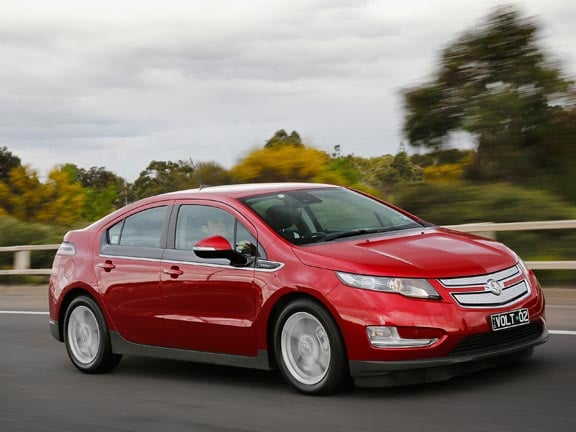
Base price: $85,000.
Powertrain and performance: Voltec electric drive system with linked lithium-ion battery modules producing 111kW/370Nm, 1.4-litre petrol generator producing 63kW, front-drive, electric-only range 87km, Combined economy 1.2 litres per 100km.
Vital statistics: 4498mm long, 1430mm high, kerb weight 1721kg, luggage capacity 300 litres, fuel tank 35 litres, 17-inch wheels on 215/55 tyres.
We like: Makes electric cars cool, no range anxiety, can charge it anywhere.
We don’t like: Astronomical price for what is essentially a Cruze E-REV, wooden brakes.
How it rates: 8/10
WHAT DO I NEED TO KNOW?
So we all know what an electric vehicle (EV) is. Well, the Holden Volt is New Zealand’s first extended-range electric vehicle (E-REV). That means you can use it as an EV, running on battery power and emitting absolutely no pollutants, but when the electric power runs out it can keep on going thanks to an on-board petrol generator. That’s the key thing, because in a conventional EV, you’d have to find the right kind of power outlet and wait a few hours.
EVs have very limited range (typically 80-120km). They take up to eight hours to recharge. Fear of running out of juice and being stranded for the best part of a working day is called ‘range anxiety’ and it’s what keeps EVs off a lot of shopping lists.
The Volt E-REV is General Motors’ new-age, anti-anxiety hero car: it’s sold as a Chevrolet in the United States, an Opel in Europe and of course a Holden here. At $85,000 it’s extremely expensive for what is essentially a plug-in Cruze (the platform and petrol generator both come from that car). But what price progress?
WHAT’S IT LIKE TO DRIVE?
It’s fun because its maker obviously has a sense of humour about its future-now credentials. When you press the start button it makes a sci-fi noise (ascending tone). Turn it off and you get the descending tone.
On electric power, Volt is silent – just a faint whine as you roll up the road. Acceleration from standstill is brisk because with an electric motor you get instant torque, although ultimately it’s no road rocket.
Nor is it a sports car. It steers and handles with authority, but it’s certainly not as lively or nimble as the Cruze on which it is based – not surprising as it carries extra weight.
Overall it’s very good, the only real dynamic downer being the brakes. They have a lot of work to do, feeding energy back to the battery pack, but the pedal is devoid of feel at low speed and disconcertingly wooden at higher velocity. It’s the kind of problem the Toyota Prius had in its first couple of generations.
What happens when the battery runs out? The petrol generator simply fires up and you keep going. The engine is merely there to drive the electric motor, so its speed may or may not bear some relationship to that of the car. Usually not. It’s odd to sit at the traffic lights and hear the petrol engine roaring away underneath…
IS IT EASY TO LIVE WITH?
Absolutely. The genius of Volt is that unlike most other EVs, it can be plugged into a standard household power point. So you can charge it anywhere, any time (it’ll put about $3 on your power bill). If your daily commute is less than 90km (that applies to 95 percent of New Zealand motorists, according to Holden), then you need never use a drop of fuel.
At least until you want to make a longer trip, which is the beauty of this E-REV – you can do that if you want to.
Volt is a four-seater only (the battery pack is mounted in the centre of the car) and the boot is a modest 300 litres, so there are some compromises to be made. But it’s still a comfortable and relatively spacious machine.
Volt does not pretend to be anything other than a ‘look at me’ car. The interior is decked out in white plastic like Moonbase Alpha and the dashboard is a garish digital affair with lots of colour and some strange graphics. Example: there’s a floating ball on the information screen – if you can keep it still you’re driving economically.
SHOULD I BUY ONE?
Let’s be honest now: EVs are still highly specialised, high-cost vehicles that only the dedicated few are prepared to purchase right now. The Volt is no different – it’s twice the price of a specced-up Cruze, so you’re going to really want to make a green statement to buy one.
But if you do, you’re getting a work of genius. In the context of EVs, I’d argue Cruze is even quite good value. Think about it: spend $60k on an electric car and you might get by for business commuting, but you’ll still need to own another vehicle for weekend use or for longer trips. With Volt, you don’t have to: it does both jobs brilliantly.
EQUIPMENT CHECKLIST
Air conditioning: Dual climate
Audio: CD, iPod compatible
Automatic lights/wipers: Yes/yes
Blind spot warning: Yes
Bluetooth: Yes
Cruise control: Yes
Driver footrest: Yes
Gas discharge headlights: No
Head-up display: No
Heated/ventilated seats: Yes/No
Keyless entry/start: Yes/Yes
Lane guidance: Yes
Leather upholstery: Yes
Parking radar: Front and rear with camera
Power boot or tailgate: No
Power seat adjustment/memory: Yes
Remote audio controls: Yes
Satellite navigation: Yes
Seat height adjustment: Yes
Self-parking technology: No
Split/folding rear seats: 40/40
Steering reach adjustment: Yes
Stop-start: Yes
Trip computer: Yes